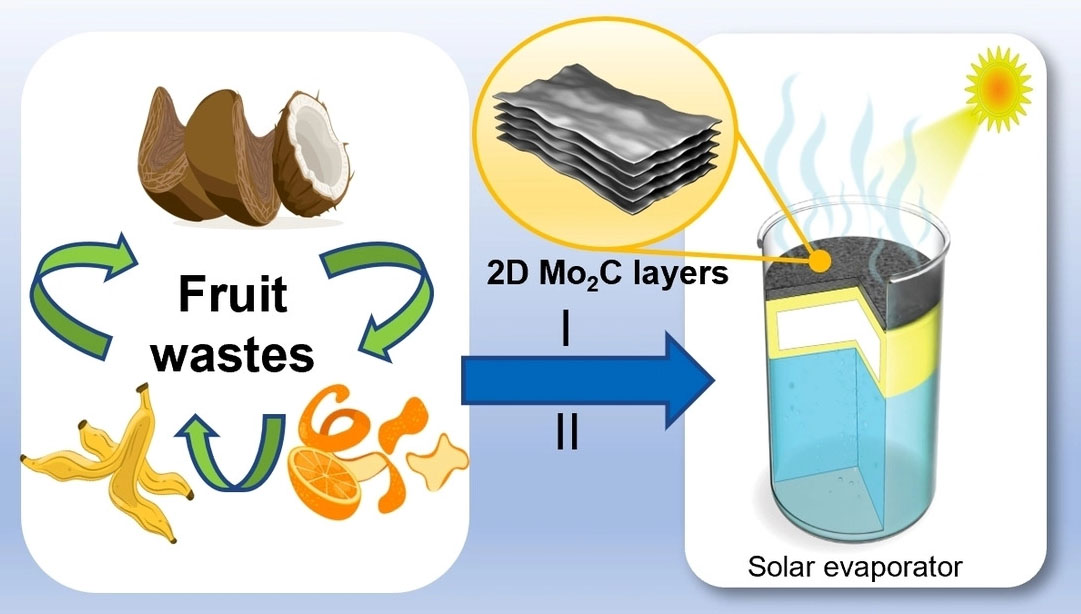| Mar 24, 2023 |
Recycling of fruit waste into a MXene solar absorber for water desalination
(Nanowerk News) Scientists from the National Institute of Education/Nanyang Technological University of Singapore developed a method for converting fruit wastes such as coconut husks, orange peels, and banana peels into a solar absorber made of MXene for efficient water desalination process.
|
|
We have reported on this research in one of our Nanowerk Spotlights: "Turning food and plastic waste into valuable nanomaterials for energy applications".
|
|
Singapore produces over 20,000 tonnes of fruit waste annually, the majority of which comes from the fruit juicing sector, which uses 50% of the fruit but discards the rest as trash, such as fruit peel. This gave Dr Edison Ang inspiration. He sees wealth where others perceive waste since wastes are free resources that may be used to create valuable products, like MXene in this example. A type of material known as MXene has outstanding light-to-heat conversion capabilities and can be utilized to build solar stills for the treatment of water using clean, renewable solar energy. This solar still can be made portable and set up easily in rural areas with limited access to electricity.
|
|
Fruit wastes were used to create MXene materials through a two-step carbonization process, and these materials were employed to create a solar absorber in a solar still for water desalination. This work has been featured in the 2022 Young Chemists theme collection in the Chemistry-A European Journal ("Sustainable Production of Molybdenum Carbide (MXene) from Fruit Wastes for Improved Solar Evaporation").
|
 |
| Graphical abstract of the work. (© Wiley-VCH Verlag)
|
|
The key findings of the paper are:
|
|
MXenes derived from fruit wastes demonstrate excellent light-to-heat conversion efficiency, with a rate of 90%. This is nearly 30% higher than that of the commercial solar absorber, which means that it is more effective at converting solar energy into heat energy.
The use of fruit waste as a source of raw materials for MXene production can significantly reduce the cost of the material. In this study, the MXene material was less expensive than commercial alternatives because one of the reactant sources was obtained for free from fruit waste.
The homemade solar still prototype that utilized MXene material showed a significant improvement in the water production rate, with an increase of approximately 50% over the existing solar still.
The purified water produced by the homemade solar still prototype met the World Health Organization (WHO) drinking water standard. This indicates that the MXene-based solar still can produce clean drinking water that is safe for human consumption.
|
|
The main focus of Dr Edison's research is to develop innovative and cost-effective methods to turn organic wastes into useful materials for solar stills that purify water. Graphite was successfully made from plastic trash in a prior study by his team, and this work was published in the Journal of Materials Chemistry A("Sustainable Development of Graphitic Carbon Nanosheets from Plastic Wastes with Efficient Photothermal Energy Conversion for Enhanced Solar Evaporation").
|
|
Both investigations showed that organic wastes can be turned into two-dimensional (2D) materials with higher values like graphite and MXene. Additionally, its distinct honeycomb structure enhances the effectiveness of light-to-heat conversion, and the 2D structure's interlayers offer numerous pathways for fast water production.
|
|
Recycling and reusing organic wastes and turning them into materials with value added, such as carbon, can lessen the negative effects of waste pollution while also lowering the cost of MXene or graphite materials and the mining of natural carbon resources. As a result, the economy and the environment will both gain significantly.
|
|
Finding suitable materials for eco-friendly and more efficient solar stills is the main challenge. Usually, non-organic impurities are mixed with organic wastes. As a result, there are only a few pure materials that can be produced using current technologies. Sorting out the different waste material types will require additional work, such as using machine learning and artificial intelligence together to enhance the quality of the waste management process.
|
|
Commercial Li-ion batteries, which are used in everything from smartphones to electric vehicles, are known to be made with graphite as a key component. MXenes, which are naturally conductive like graphite and have a 2D structure, are useful for storing charges in batteries and may soon be used in the manufacture of batteries. The MXene made from fruit waste therefore has potential uses that go far beyond water purification.
|
|
Dr Edison Ang and his student, Marliyana Aizudin, also shared their research with primary school students. This is in line with Singapore's Green Plan 2030 and the Eco Stewardship Programme, demonstrating his dedication to promoting sustainability and environmental awareness in Singapore and fostering a more sustainable and environmentally conscious society for the future by educating the next generation on the importance of sustainability. It is essential to continue promoting sustainability and incorporating it into educational curricula to address the pressing environmental challenges faced by Singapore and the world.
|

